Jeff Grubb's Blog, page 34
July 15, 2019
Is Cthulhu REALLY a Great Old One?
Here's something that has always bothered me. In H.P.Lovecraft's "The Call of Cthulhu", there's the following passage:
Either way, it is is an interesting take on things. If he's a priest who venerates these Great Old Ones, he's subordinate to and separate from them, and the Great Old Ones (of which later writers have constructed an entire pantheon) are unknowable, godish beings who we have never really met. If is a priest among the Great Old Ones, what do these Great Old Ones worship?
Hang on, it gets even more interesting in the next paragraph.
So it seems, from this reading, that the entire later industry of Great Cthulhu as one of a pantheon of elder eldritch beings may be off. His fictional worshipers, as well as later real-world chroniclers, have confused and conflated the two, promoting the priest to the godhood itself. Of course, all of this is from a highly unreliable narrator, a mad and degenerate worshiper of these Great Old Ones, On the other hand this is a primary source, THE primary source, of Cthulhu lore.
Anyone have an theory on this?
More later,
They worshipped, so they said, the Great Old Ones who lived ages before there were any men, and who came to the young world out of the sky. Those Old Ones were gone now, inside the earth and under the sea; but their dead bodies had told their secrets in dreams to the first men, who formed a cult which had never died. This was that cult, and the prisoners said it had always existed and always would exist, hidden in distant wastes and dark places all over the world until the time when the great priest Cthulhu, from his dark house in the mighty city of R’lyeh under the waters, should rise and bring the earth again beneath his sway. Some day he would call, when the stars were ready, and the secret cult would always be waiting to liberate himBoldface and underlines are mine.Cthulhu, who in later texts is recognized as a one of the Great Old Ones, is referred to here as being a "great priest". Does this mean that Cthulhu is a priest OF these Great Ones, or is he one of the Great Old Ones, and his position among them is that of a Priest (i.e. - he's the cleric of the party)?
Either way, it is is an interesting take on things. If he's a priest who venerates these Great Old Ones, he's subordinate to and separate from them, and the Great Old Ones (of which later writers have constructed an entire pantheon) are unknowable, godish beings who we have never really met. If is a priest among the Great Old Ones, what do these Great Old Ones worship?
Hang on, it gets even more interesting in the next paragraph.
So no one has ever seen the Old Ones, but here's a statue of Cthulhu, which we know from the later in the story is a pretty fair representation of his titanic majesty.Meanwhile no more must be told. There was a secret which even torture could not extract. Mankind was not absolutely alone among the conscious things of earth, for shapes came out of the dark to visit the faithful few. But these were not the Great Old Ones. No man had ever seen the Old Ones. The carven idol was great Cthulhu, but none might say whether or not the others were precisely like him. No one could read the old writing now, but things were told by word of mouth. The chanted ritual was not the secret—that was never spoken aloud, only whispered. The chant meant only this: “In his house at R’lyeh dead Cthulhu waits dreaming.
So it seems, from this reading, that the entire later industry of Great Cthulhu as one of a pantheon of elder eldritch beings may be off. His fictional worshipers, as well as later real-world chroniclers, have confused and conflated the two, promoting the priest to the godhood itself. Of course, all of this is from a highly unreliable narrator, a mad and degenerate worshiper of these Great Old Ones, On the other hand this is a primary source, THE primary source, of Cthulhu lore.
Anyone have an theory on this?
More later,
Published on July 15, 2019 08:44
July 7, 2019
MADness Takes Its Toll
There are other, more important things going on in the world, but I'm going to talk about the demise of MAD Magazine.
And yeah, it's a demise. Death. Pushing up daises. Cue the Choir Celestial. It is an ex-Magazine. As the news hit and people reacted badly, the spin control engaged - it wasn't QUITE dead. It would do some reprint stuff. And a yearly annual. And the reprints would be in the direct sale trade, and the chain bookstores - those that are left.
Look. LIFE Magazine died in 1972 as a weekly magazine, but it still shows up at the grocery check-outs with special issues on the latest film or some ancient anniversary. But LIFE is dead. Ditto MAD.
And I've taken the news with the stoicism of a hearing of the passing of some old friend from high school that you haven't talked to in three decades. As a kid, MAD magazine was a staple in the tree fort in the backyard, and the smell of the slightly moldy, aging paper stock stays with me to this day. And we got the paperbacks that reprinted stuff from the fifties and early sixties as well. Nostalgia is strong, but not strong enough to continue support over the years.
MAD defined for me what New York was like, along with its native New Yorkers. It was hip, sophisticated, cynical, urban, multi-cultural. It was sarcastic and sardonic. It was smart and infantile at the same time. It was definitely left of center (though it out time to lash liberal hypocrisies as well as conservative ones) and any commercial. It was educated. I knew a lot more about Broadway musicals and current films from the Mad satires. And the music parodies, mostly written by Frank Jacobs.Those I can still remember better than the last book I read.
A favorite Broadway parody - "My Fair Ad-Man", with Cary Grant trying to turn a beatnik Frank Sinatra into a proper grey-flannel suit. A favorite song - "Hello, Deli".( Hello, Deli. This is Joe, Deli, Will you please send up a hot corned beef on rye).
And the talent. Names to conjure with like Mort Drucker, Jack Davis, Dave Berg, and Don Martin (When naming Asura for GW, I always recommended their names sound like Don Martin's sound affects). Sergio Aragonnes and his marginals. Al Jaffee and his fold-ins Even the tags at the top of the page held a chuckle.There was a lot of depth going on in the page, a lot of stuff all happening at once. It was really, really good.
And yeah, I know that the magazine had fallen on the hard times of not being sufficiently profitable for its corporate overhead. Bill Gaines ran it his way until he passed, and since there it has been a slow cascade of corporate decisions, each made while looking over its corporate shoulder to see if THIS would be the one that killed it. Folding it into the greater Warner Brothers empire, cutting pay rates, reduced shipping schedules, moving the whole furshlugginer operation to California. And now the zombie-like demise where the Brand survives but everyone who made it a brand is gone. Feasting off the corpse.
But as I said,. I haven't read it in decades. I can't remember the last thing I read in the magazine, the last issue I bought. I moved on to other things, as one does. I picked up a lot of National Lampoons in college (dead in 1998 (after five years of sporadic publication), and SPY magazine therefore (Also dead in 1998), and suppose my current fling with the New Yorker is that most recent engagement with the New York State of mind, of an era when Manhattan was the hub of the publishing universe, with all the intelligentsia swarming around it. And MAD was its court jester.
Farewell MAD. Farewell, Alfred E. Neuman. Farewell, those bits and bobs and punchlines that people of my age can quote and discover others get the joke. It's been real.
More later,
And yeah, it's a demise. Death. Pushing up daises. Cue the Choir Celestial. It is an ex-Magazine. As the news hit and people reacted badly, the spin control engaged - it wasn't QUITE dead. It would do some reprint stuff. And a yearly annual. And the reprints would be in the direct sale trade, and the chain bookstores - those that are left.
Look. LIFE Magazine died in 1972 as a weekly magazine, but it still shows up at the grocery check-outs with special issues on the latest film or some ancient anniversary. But LIFE is dead. Ditto MAD.
And I've taken the news with the stoicism of a hearing of the passing of some old friend from high school that you haven't talked to in three decades. As a kid, MAD magazine was a staple in the tree fort in the backyard, and the smell of the slightly moldy, aging paper stock stays with me to this day. And we got the paperbacks that reprinted stuff from the fifties and early sixties as well. Nostalgia is strong, but not strong enough to continue support over the years.
MAD defined for me what New York was like, along with its native New Yorkers. It was hip, sophisticated, cynical, urban, multi-cultural. It was sarcastic and sardonic. It was smart and infantile at the same time. It was definitely left of center (though it out time to lash liberal hypocrisies as well as conservative ones) and any commercial. It was educated. I knew a lot more about Broadway musicals and current films from the Mad satires. And the music parodies, mostly written by Frank Jacobs.Those I can still remember better than the last book I read.
A favorite Broadway parody - "My Fair Ad-Man", with Cary Grant trying to turn a beatnik Frank Sinatra into a proper grey-flannel suit. A favorite song - "Hello, Deli".( Hello, Deli. This is Joe, Deli, Will you please send up a hot corned beef on rye).
And the talent. Names to conjure with like Mort Drucker, Jack Davis, Dave Berg, and Don Martin (When naming Asura for GW, I always recommended their names sound like Don Martin's sound affects). Sergio Aragonnes and his marginals. Al Jaffee and his fold-ins Even the tags at the top of the page held a chuckle.There was a lot of depth going on in the page, a lot of stuff all happening at once. It was really, really good.
And yeah, I know that the magazine had fallen on the hard times of not being sufficiently profitable for its corporate overhead. Bill Gaines ran it his way until he passed, and since there it has been a slow cascade of corporate decisions, each made while looking over its corporate shoulder to see if THIS would be the one that killed it. Folding it into the greater Warner Brothers empire, cutting pay rates, reduced shipping schedules, moving the whole furshlugginer operation to California. And now the zombie-like demise where the Brand survives but everyone who made it a brand is gone. Feasting off the corpse.
But as I said,. I haven't read it in decades. I can't remember the last thing I read in the magazine, the last issue I bought. I moved on to other things, as one does. I picked up a lot of National Lampoons in college (dead in 1998 (after five years of sporadic publication), and SPY magazine therefore (Also dead in 1998), and suppose my current fling with the New Yorker is that most recent engagement with the New York State of mind, of an era when Manhattan was the hub of the publishing universe, with all the intelligentsia swarming around it. And MAD was its court jester.
Farewell MAD. Farewell, Alfred E. Neuman. Farewell, those bits and bobs and punchlines that people of my age can quote and discover others get the joke. It's been real.
More later,
Published on July 07, 2019 10:50
July 4, 2019
Theatre: Octopuses as Elves
 The Last World Octopus Wrestling Champion, Book, Music and Lyrics by Justin Hueratas, Additional Music, Arrangements, and Orchestrations by Steven Tran, Directed by Mathew Wright. Arts West, through July 28 (Sorry, folks, it's over).
The Last World Octopus Wrestling Champion, Book, Music and Lyrics by Justin Hueratas, Additional Music, Arrangements, and Orchestrations by Steven Tran, Directed by Mathew Wright. Arts West, through July 28 (Sorry, folks, it's over).What a minute, didn't you say you were done for the season with plays? Well, yeah, but in the program book for the Seattle Rep there was an advert for Arts West over in West Seattle for a new musical by Justin Huertas. Mr. Huertas, in addition to acting in Tiny Beautiful Things, was the mastermind behind Lizard Boy a few year back, which was one of the Lovely Bride's favorite plays.
Let me talk about the venue for a moment, since its new to this space. Arts West is nicely situated at the Junction, a business district in West Seattle. The space is intimate without being tight. It is theater in the round for this production, which often means that the actors have to keep moving around so you don't spend the performance looking at their Captain America-level backsides. The Lovely Bride and I had front row seats, but there was enough room between us and the stage proper for the actors to move around without worrying about tripping over us.
Anyway, the play: Octopus wrestling was a thing in the Pacific Northwest at one time. Divers would hunt octopuses off the Seattle's shores, bring them up bare-handed, and the diver who brought up the biggest octopus would be the winner. Grace (Corinna Lapid Munter) won the trophy the last time it had been done, eighteen years back. She doesn't talk about it anymore, and had her son Todd (Christian Quinto) hide the trophy and never tell daughter Lee (Rachel Guyer-Mafune). who, by the way, just turned 18 and is going to be a freshman at the U-Dubb. There Lee meets Nia (Porscha Shaw), who she is immediately attracted to, and David (Tyler Rogers) a marine biologist and octopus fan.
Lee finds the trophy and wants to know more about Grace's octopus wrestling days. Grace is now plagued by the sudden incursions by the Undertow, a sea spirit, who sends starfish and bivalves to attack her. And Lee starts mutating into something more mollusk-y and discovers Nia has the same problems. And Todd and David connect. And truths are revealed and Grace understands and Lee grows.
DId I mention that it's a musical? Yeah, It's a musical, and all-singing, all-dancing extravaganza. Well, mostly singing. A lot of good dancing and choreographed conflicts. The characters switch off from their roles to become a narrative Greek chorus and representatives of the Undertow. The actors have mini-mikes on their foreheads like South Asian bindi, and the sound levels were perfect. Live musicians off-stage in perfect harmony for the space. Having had to deal with wonky sound in much bigger halls, this was great.
The actors were top-notch as well. Ms. Munter brings the necessary strength and fire, both physically and emotionally, for her character. Guyer-Mafune is a very different character than the one she portrayed in Feathers and Teeth, and just rocks the role. Porsha Shaw previously showed up in Nina Simone's Four Women, annd is excellent as Nia, both in voice and acting (Nia's a deeper character). Quinto and Rogers get to be a little broader and comedic, but they both bring a sweetness to their characters that makes everything hang together.
Ultimately, this the tale of the fae, the mystical and mythical people of the forest, transported from the Black Forest and the Brothers Grimm in to the stony beaches of of the PNW. The alien and inhuman elves and spirits are replaced with another intelligence, cool and aquatic, in the soul-drenched eyes of the cephalopod. The play is also about love in a great handful of permutation, about family, and mixed in with enough Seattle references to connect with any native Seattleite.
How good was it? The Lovely Bride is checking out next season's Art West schedule, and I'm willing to praise a play that I has since gone by the wayside. I'd usually say check it out, but instead I can hope that some other group does it.
More later,
Published on July 04, 2019 13:09
June 19, 2019
The Return of No Quarter - X Marks the Spot
It is that time of year when the collectable quarters show up from the America The Beautiful series, which is shorter than the National Park/Monument/Rec Area/Seashore/whatever. And while we are rolling down the countdown, this year as produced the most political collection of quarters yet, intentional or not. To you they may be pocket change, but they hold deeper meanings.
As always, we rate the quarters, based on design, subject matter, and art. Reviews are entirely subjective, and reflect the views of the management, and not necessarily anyone with any real authority.
Way Cool =A
Not Bad = B
Kinda Lame/Meh = C
Very Lame = D
Facebook makes better cryptocurrency = E
Here we go:
Lowell National Historical Park - Massachusetts
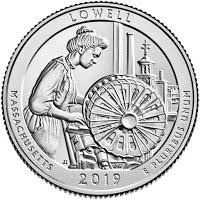 This one is interesting - when you talk about New England in the Industrial Revolution, you get images of coal-darkened brick buildings filled with young women working long, tedious hours in the service of dangerous machines, lumped together in small spaces. Corporate tyranny. Company towns. Sweat shops.
This one is interesting - when you talk about New England in the Industrial Revolution, you get images of coal-darkened brick buildings filled with young women working long, tedious hours in the service of dangerous machines, lumped together in small spaces. Corporate tyranny. Company towns. Sweat shops.
But. They also were a way for women to get off the farm and improve their lives. It brought them together, and in bringing them together, empowered them to work together. Industrial safety. Unions. Abolition. All of these came out of these women gathered together. They improved their lives and started working to improve others. The anti-slavery movements got a lot of start and support in New England, at the automated looms within those industrial vaults.
The coin itself has a great design, cramming together a lot of elements with a small space. The "mill girl" is dominant, tending to a circular bobbin battery (The thing that looks like a steamship wheel)
It is a revolutionary quarter, with more than meets the eye.
Rating: A (Way Cool - Mostly for the back story).
American Memorial Park - Northern Mariana Islands
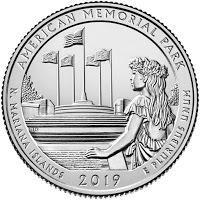 This quarter has more than meets the eye as well, but not always that good.
This quarter has more than meets the eye as well, but not always that good.
The Marina Islands were one of those island chains we liberated from Japan during WWII, and then kept. So part of it is the "We're part of the US, Really! of the flag plaza.
But for the longest time, the Marinas were used as a textile hub, particularly during the Cold War years when we didn't trade with Communist China. Raw materials were shipped in - there was a captive workforce of native peoples, and you could ship stuff out with the Made in the USA tag. But then the thaw came, and we could get fabric easily from China, and the bottom dropped out. And the islands became better known for sex tourism (and sex slavery). This was reported heavily ten years back, but I can't seem to find any articles to the tune of "We've cleaned things up - things are MUCH better now for the people that live there").
So, yeah. It is a kinda creepy coin, when you know what's going on. Nice design, but I wouldn't hold onto it too long.
Rating: B (Not Bad, C if you think about it).
War in the Pacific National Historical Park - Guam
 Well, this one is a little more honest than the previous one. Guam was another Pacific island that we captured and forgot to give back. It was a big battle, and one of those chunks in the twentieth cent that we really sent people to, so I am cool with the honesty of the presentation in a way that the North Marianas coin does not.
Well, this one is a little more honest than the previous one. Guam was another Pacific island that we captured and forgot to give back. It was a big battle, and one of those chunks in the twentieth cent that we really sent people to, so I am cool with the honesty of the presentation in a way that the North Marianas coin does not.
The coin itself has a nice design, showing Willy and Joe single-handedly taking the beaches. But there is a hint of life and activity missing from a lot of other coins. The use of the white space for the lagoon also works to highlight the soldiers. I don't think anyone born after the boomer years would recognize the LTV, and the ships on the horizon look more like power plants than navy units.
The text accompanying this on its web site talks about the park's rich biological diversity, of which you see absolutely nothing of other than a couple trees in the middle distance. Better that it faces up to its name and owns it, then giving a head-nod to the natural beauty when the picture is the marines storming the island.
Still, an OK coin that carries its message forward.
Rating: B (Not Bad).
San Antonio Missions National Historical Park - Texas
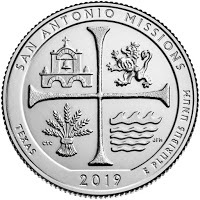 This one is weird for a number of ways. First off, it is a coin that swipes pretty much another coins' design. This is a Spanish real with minor modifications. The upper right has the Spanish lion (complete with monarchic crown), the upper left replaces the traditional castle (because, Castile) with a mission itself, the lower left shows grain, a regular staple of state flags from agricultural state, and the last is ... water, to show the importance the missions had in creating canals to husband the water. It definitely is selling the message that we came in, conquered, and turned the land to our profit.
This one is weird for a number of ways. First off, it is a coin that swipes pretty much another coins' design. This is a Spanish real with minor modifications. The upper right has the Spanish lion (complete with monarchic crown), the upper left replaces the traditional castle (because, Castile) with a mission itself, the lower left shows grain, a regular staple of state flags from agricultural state, and the last is ... water, to show the importance the missions had in creating canals to husband the water. It definitely is selling the message that we came in, conquered, and turned the land to our profit.
When I was in grade school, we saw innumerable educational films that ended with the line - "Thanks to (fill in the blank) and irrigation, we have made the desert bloom". This coin reminds me of those films.
Oh, and it is divided into quadrants by a Spanish cross. Because putting "In God We Trust" on the money wasn't ENOUGH of a tell.
The mission system was another one of those politically charged points of history. The Spanish settlers spread missions from Texas to California, to civilize (cough) and enlighten the native population. Plus convert them to Catholicism by fire and sword, if need be. And to create a servile working population to work in the fields. Mexico (and those parts of the US that were once Mexico) did not engage as much in the hard genocide of the American Plains, but rather a softer form of erasure of the native ways and conversion into a more acceptable European model.
The coin itself is pretty cool looking, but then, it has been road-tested as another country's coin for centuries. It balances a lot of elements in the way that old state flags, tossing a bunch of elements on the fabric and topping it with a saying like "Virtue" or "I Got Mine" in Latin. But like the Marianas coin, it brings up a lot of questions for discussion.
Nice coin, but you're copying someone else's homework
Rating: C (Meh - I mean, it was cool, like 400 years ago)
Frank Church River of No Return Wilderness - Idaho
 OK, Great name. I mean River of NO RETURN. You can just hear the thunder after you announce this coin.
OK, Great name. I mean River of NO RETURN. You can just hear the thunder after you announce this coin.
"Your quest will send you down the RIVER OF NO RETURN!" (Crack of thunder, horses whinnying, musical sting).
Anyway, the reason it is called the River of No Return is because of all the whitewater rapids and swift currents along its length, which made it easy (if dangerous) to go downstream, but near-impossible go back upstream. And the coin captures this with a boat just cresting a hydraulic. Nice animation. They could have just gone with some animal and a mountain, but instead the creators of this coin has opted for a more engaged and dynamic look.
The coin itself keeps from looking too cluttered, despite the large amount of elements (rapids, boat, dude in boat, canyon walls, trees) with a camera angle that creates a clear white space to the top, pushing the feeling of majesty and danger as well as framing the words "Wilderness".
The Wilderness in question is a HUGE swath of Idaho that has so far resisted attempts at development and exploitation. In its formation, it swallowed six national forests It is named after Idaho Senator Frank Church, who was instrumental is creating the wilderness area in the first place, along with a lot of other cool stuff.
So, cool name, cool coin, cool presentation, cool backstory. What is not to love?
Rating: A (Feel good when you find it in your change).
Next up: "And the Rest!" - The pick-up states - Kansas! Connecticut! Samoa! And maybe Alabama, which is the last one on 2021, and maybe, just maybe, they'll slide it in with the others.
More later,
As always, we rate the quarters, based on design, subject matter, and art. Reviews are entirely subjective, and reflect the views of the management, and not necessarily anyone with any real authority.
Way Cool =A
Not Bad = B
Kinda Lame/Meh = C
Very Lame = D
Facebook makes better cryptocurrency = E
Here we go:
Lowell National Historical Park - Massachusetts
 This one is interesting - when you talk about New England in the Industrial Revolution, you get images of coal-darkened brick buildings filled with young women working long, tedious hours in the service of dangerous machines, lumped together in small spaces. Corporate tyranny. Company towns. Sweat shops.
This one is interesting - when you talk about New England in the Industrial Revolution, you get images of coal-darkened brick buildings filled with young women working long, tedious hours in the service of dangerous machines, lumped together in small spaces. Corporate tyranny. Company towns. Sweat shops.But. They also were a way for women to get off the farm and improve their lives. It brought them together, and in bringing them together, empowered them to work together. Industrial safety. Unions. Abolition. All of these came out of these women gathered together. They improved their lives and started working to improve others. The anti-slavery movements got a lot of start and support in New England, at the automated looms within those industrial vaults.
The coin itself has a great design, cramming together a lot of elements with a small space. The "mill girl" is dominant, tending to a circular bobbin battery (The thing that looks like a steamship wheel)
It is a revolutionary quarter, with more than meets the eye.
Rating: A (Way Cool - Mostly for the back story).
American Memorial Park - Northern Mariana Islands
 This quarter has more than meets the eye as well, but not always that good.
This quarter has more than meets the eye as well, but not always that good.The Marina Islands were one of those island chains we liberated from Japan during WWII, and then kept. So part of it is the "We're part of the US, Really! of the flag plaza.
But for the longest time, the Marinas were used as a textile hub, particularly during the Cold War years when we didn't trade with Communist China. Raw materials were shipped in - there was a captive workforce of native peoples, and you could ship stuff out with the Made in the USA tag. But then the thaw came, and we could get fabric easily from China, and the bottom dropped out. And the islands became better known for sex tourism (and sex slavery). This was reported heavily ten years back, but I can't seem to find any articles to the tune of "We've cleaned things up - things are MUCH better now for the people that live there").
So, yeah. It is a kinda creepy coin, when you know what's going on. Nice design, but I wouldn't hold onto it too long.
Rating: B (Not Bad, C if you think about it).
War in the Pacific National Historical Park - Guam
 Well, this one is a little more honest than the previous one. Guam was another Pacific island that we captured and forgot to give back. It was a big battle, and one of those chunks in the twentieth cent that we really sent people to, so I am cool with the honesty of the presentation in a way that the North Marianas coin does not.
Well, this one is a little more honest than the previous one. Guam was another Pacific island that we captured and forgot to give back. It was a big battle, and one of those chunks in the twentieth cent that we really sent people to, so I am cool with the honesty of the presentation in a way that the North Marianas coin does not.The coin itself has a nice design, showing Willy and Joe single-handedly taking the beaches. But there is a hint of life and activity missing from a lot of other coins. The use of the white space for the lagoon also works to highlight the soldiers. I don't think anyone born after the boomer years would recognize the LTV, and the ships on the horizon look more like power plants than navy units.
The text accompanying this on its web site talks about the park's rich biological diversity, of which you see absolutely nothing of other than a couple trees in the middle distance. Better that it faces up to its name and owns it, then giving a head-nod to the natural beauty when the picture is the marines storming the island.
Still, an OK coin that carries its message forward.
Rating: B (Not Bad).
San Antonio Missions National Historical Park - Texas
 This one is weird for a number of ways. First off, it is a coin that swipes pretty much another coins' design. This is a Spanish real with minor modifications. The upper right has the Spanish lion (complete with monarchic crown), the upper left replaces the traditional castle (because, Castile) with a mission itself, the lower left shows grain, a regular staple of state flags from agricultural state, and the last is ... water, to show the importance the missions had in creating canals to husband the water. It definitely is selling the message that we came in, conquered, and turned the land to our profit.
This one is weird for a number of ways. First off, it is a coin that swipes pretty much another coins' design. This is a Spanish real with minor modifications. The upper right has the Spanish lion (complete with monarchic crown), the upper left replaces the traditional castle (because, Castile) with a mission itself, the lower left shows grain, a regular staple of state flags from agricultural state, and the last is ... water, to show the importance the missions had in creating canals to husband the water. It definitely is selling the message that we came in, conquered, and turned the land to our profit.When I was in grade school, we saw innumerable educational films that ended with the line - "Thanks to (fill in the blank) and irrigation, we have made the desert bloom". This coin reminds me of those films.
Oh, and it is divided into quadrants by a Spanish cross. Because putting "In God We Trust" on the money wasn't ENOUGH of a tell.
The mission system was another one of those politically charged points of history. The Spanish settlers spread missions from Texas to California, to civilize (cough) and enlighten the native population. Plus convert them to Catholicism by fire and sword, if need be. And to create a servile working population to work in the fields. Mexico (and those parts of the US that were once Mexico) did not engage as much in the hard genocide of the American Plains, but rather a softer form of erasure of the native ways and conversion into a more acceptable European model.
The coin itself is pretty cool looking, but then, it has been road-tested as another country's coin for centuries. It balances a lot of elements in the way that old state flags, tossing a bunch of elements on the fabric and topping it with a saying like "Virtue" or "I Got Mine" in Latin. But like the Marianas coin, it brings up a lot of questions for discussion.
Nice coin, but you're copying someone else's homework
Rating: C (Meh - I mean, it was cool, like 400 years ago)
Frank Church River of No Return Wilderness - Idaho
 OK, Great name. I mean River of NO RETURN. You can just hear the thunder after you announce this coin.
OK, Great name. I mean River of NO RETURN. You can just hear the thunder after you announce this coin."Your quest will send you down the RIVER OF NO RETURN!" (Crack of thunder, horses whinnying, musical sting).
Anyway, the reason it is called the River of No Return is because of all the whitewater rapids and swift currents along its length, which made it easy (if dangerous) to go downstream, but near-impossible go back upstream. And the coin captures this with a boat just cresting a hydraulic. Nice animation. They could have just gone with some animal and a mountain, but instead the creators of this coin has opted for a more engaged and dynamic look.
The coin itself keeps from looking too cluttered, despite the large amount of elements (rapids, boat, dude in boat, canyon walls, trees) with a camera angle that creates a clear white space to the top, pushing the feeling of majesty and danger as well as framing the words "Wilderness".
The Wilderness in question is a HUGE swath of Idaho that has so far resisted attempts at development and exploitation. In its formation, it swallowed six national forests It is named after Idaho Senator Frank Church, who was instrumental is creating the wilderness area in the first place, along with a lot of other cool stuff.
So, cool name, cool coin, cool presentation, cool backstory. What is not to love?
Rating: A (Feel good when you find it in your change).
Next up: "And the Rest!" - The pick-up states - Kansas! Connecticut! Samoa! And maybe Alabama, which is the last one on 2021, and maybe, just maybe, they'll slide it in with the others.
More later,
Published on June 19, 2019 12:10
June 18, 2019
Theatre: Other People's Mail
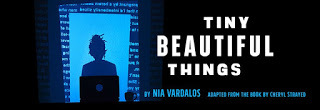 Tiny Beautiful Things, - Based on the book by Cheryle Strayed, Adapted for the Stage by Nia Vardalos, Co-Conceived byi Marshall Heyman, Thomas Kail, and Nia Vardalos, Directed by Courtney Sale, Seattle SEP through June 23rd.
Tiny Beautiful Things, - Based on the book by Cheryle Strayed, Adapted for the Stage by Nia Vardalos, Co-Conceived byi Marshall Heyman, Thomas Kail, and Nia Vardalos, Directed by Courtney Sale, Seattle SEP through June 23rd.Review first, then a summary of the season.
Tiny Beautiful Things is a collection of advice articles spread out into a theatrical format. A new advice columnist (Julia Briskman) settles into her job under the pseudonym Sugar, working from home, and advising people who write into her column. In the process she reveals her own traumas and backstory. I can't say the letters become therapy for her, but it does help her define how she has dealt with abuse, drugs, family and marital problems in the past It is less of a play than a greatest hits collection - the plot has only the slightest arc, and problems posed by the writers are never really resolved (so far as we know).
As she answers those seeking advice, the house becomes haunted with the spirits of the letter-writers, played by three actors (Chantal Groat, Justin Huertas, and Charles Leggett), who meld into a stream of supplicants, alternating begging for advice and castigating Sugar for lacking consistency in her replies. And all the actors are brilliant in their parts as well as being familiar faces, having been in plays old and new at the Rep: Julia Briskman was in The Beard of Avon, The Imaginary Invalid, adn The Servant to Two Masters, Chantal Degroat popped up in Well, Charles Leggett has been everywhere (A Raisin in the Sun, both of the recent Sherlock Holmes plays, Of Mice and Men, Glengarry Glen Ross, Opus), and Justin Huertas was the mind behind and the star of Lizard Boy.
And this is where the Rep truly acts like a repertory company - you get to see actors that you know, as opposed to some polished road show that swoops in, adapts for the particular stage and audience, does its listed number of shows, then swoops out to the next gig. The play itself is slight, but the actors sparkle, feeding off each other, dropping into and out of conversations, and giving Sugar company as they take over her home.
And her home is probably the most Seattle-like stage I have seen, right down to the games in the corner, the Xbox hooked up to the TV (playing Minecraft), the IKEA furniture, and the multi-toned walls. Yes, the place looks lived in, and fits the nature of the performances.
The play is a slight thing, but the actors are great. It wraps up this weekend, and there are worse ways to spend a Sunday matinee.
Tiny Beautiful Things wraps up the season for the Rep, and it has been a little .... weird this time out. And I think part of it is because so much of it had sources in other media. Thousand Splendid Suns was an adaptation of a book. A People's History rested firmly on a foundation of Howard Zinn (and yeah, I bailed on listening to all of the performances about a third of the way in), Last of the Boys sets itself on MacNamara's biography. A Doll's House Part 2 comes out of a Doll's House Part One (so that's at least still theatre). Nina Simone was deeply drenched in her music. I THINK The Woman in Black was fully original, and In the Heights is on the boards primarily because of its later relative, Hamilton.
And Tiny Beautiful Things is based on a book which in turn was based on articles. This was a season where you needed a lot more backstory that previous years. I don't know if that was its intention, or it just worked out that way. But everything this year seemed to be leaning on something else.
There was good stuff - The Woman in Black was great, and I'm a fan of A People's History, but the bulk of the season felt like there were jokes I was missing, references that went right past me, things that required some prep time. I dunno - I can sustain repeated Shakespeare and Moliere and August Wilson until the scripts themselves become translucent from wear and the print fades to grey, and I can get behind new works that are experimental, but this season? This season was sort of other people's stories, cut and fit to the stage.
The advantage of all this is that, of course, there is a next season as well, and I will embrace that as well. And maybe I will be talking about other things than just plays in this blog,
More later,.
Published on June 18, 2019 17:14
May 7, 2019
Play: Musical Number
Nina Simone: Four Women by Christina Ham, Directed by Valerie Curtis-Newton. Seattle Rep
through June 2.
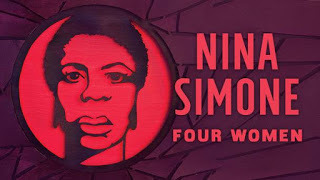 Every year the Rep throws into its mix a music-based production. Woody Guthrie, a celebration of Americana, a drag cabaret recasting modern pop as 1920s hits, a storyteller with an accordion. Success is often mixed.
Every year the Rep throws into its mix a music-based production. Woody Guthrie, a celebration of Americana, a drag cabaret recasting modern pop as 1920s hits, a storyteller with an accordion. Success is often mixed.Nina Simone is a singer I have not heard much of: her stance on Civil Rights (and moving to an overseas label) resulted in her being pretty much disappeared in popular media. She made her claim with her brilliance on the keyboard and her vocals - unable to break through the color barrier in classical music, she turned to nightclubs and established herself there. Other singers like Eartha Kitt and Aretha Franklin weathered their political opinions, but Simone was not as fortunate. World-wide she's well-known.
The turning point for Simone was the 16th Street Baptist Church Bombing in Birmingham in September of 1963, which killed four children - Addie Mae Collins, Cynthia Wesley, Carole Robertson, and Carol Denise McNair. Previously she had made her mark singing from "Porgy and Bess" to comfortable white audiences. The bombing in Birmingham radicalized her and she wrote her first protest song - "Mississippi Goddam" supposedly in an hour, and released it in 1964.
The play moves Simone to the interior of the church in the wake of the bombing - the cross is toppled but the piano survives. Simone (Shontina Vernon) is seething with rage at the deaths, and seeking to express it in her music. She is joined by three refugees from the riots and water cannons outside - Maid Sarah (Shaunyce Omar), mixed-race activist (Britney Nicole Simpson), and prostitute Sweet Thing (Porsha Shaw). Together, the four women are characters from another Simone song, "Four Women". The women spar and bicker as Simone wrings her lyrics out and the ghosts of the children cry for justice.
Does it work? Sorta. The back stories and personal secrets of the characters are presented too easily for the distrust they have for each other. There are calls for sisterhood and solidarity, but also some circular firing squads as they complain of ground-level challenges to the movement as opposed to the oppression of the overclass white males. The songs don't always fit exactly right into the play that surrounds them, and a lot of them are from Simone's later works. As a result, you don't a good feeling of the singer's own journey into demanding justice.
The singers are all strong, with Shaunyce Omar as the strongest of the group - though her character says that singing in the choir is for when you're not good enough for soloist, she's definitely the solo performance. Vernon's Nina was often undermiked and overpowered by the music itself, and while the lines were there, the imperious nature of diva only rarely surfaces.
Yet the show collects itself and rallies to an excellent finale in the song :"Four Women", and in the encore "Freedom Song" (By Vernon, not Simone) was a perfect capper. In the conflict of the four women, there is the discomfort of the past and the uneasiness we are seeing outside our window today. Our churches, temples, and mosques are burning today, and the darkness Simone struggles against is still with us. So call it a bittersweet ending, hopeful but wary about what tomorrow brings.
More later,
Published on May 07, 2019 08:41
April 9, 2019
Play: Nightmare Creatures
Feathers and Teeth by Charise Castro Smith, Directed by Bobbin Ramsey Washington ensemble Theatre, 12 Ave Arts, through April 15.
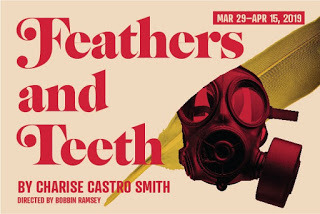
I review a lot of plays in this space, but the overwhelming majority are with the Seattle Rep because, you know, season tickets. So it is a fairly comfortable process. But the chance sometimes offers itself to get out of one's comfort zone and find a new venue and a new attitude to towards theatre. In the case of Feathers and Teeth, a colleague's working group had the chance to provide animations for this show, and I promised I would show up. Glad I did. But more about that later.
12 Ave Arts is a nice, modern, small (about 100 seats) space up on Capitol Hill overlooking downtown Seattle. And if the major theaters playing musicals reaching up the avenues to the Seattle Space Needle area are the Broadway of Seattle, this area of the city is off-Broadway. Literally. No, really. Broadway is the main spine along the top of Cap Hill and this theater (and others) are a couple blocks east. The 12 was opposite the space where long ago, we watched Mike Daisey speak of famous men, but I haven't been back to it in years.
Anyway, the play. Christine (Rachel Guyer-Mafune) is 13 years old and is convinced that her future step-mom is a demon. Carol (Samie Spring Detzer) in the potential step-mom/demon in question, a nurse who came into the house to help Christine's terminally ill mom and now, after mom's death, is intent on staying on. Arthur (Brandon J. Simmons) is the hapless/helpless/hopeless father figure who is the third leg of this familial triangle. Hugo (James Shilling) is the German kid from next door.
That's not completely accurate, but that's close enough for discussion. Because one of the things about Feathers and Teeth is that it keeps you off-balance throughout. Christine may be persecuted but she may be psychotic. Carol may be a candy-coated demon or she might just be merely mortal and manipulative. Arthur is an 80s sitcom dumb dad, a conciliator, and/or something much worse. Hugo is pretty much Hugo. But the off-balance nature is in part how quickly the characters pivot from one emotional state to the another. Carol goes from sugar sweet to vamping to vampiring easily, while Christine rolls from 13-years old to would-be Buffy the vampire slayer. It is sort like iCarly crossed with grand-guignol theatre.
Arthur shows up early with blood on his hands early on. He ran over ... something ... in the driveway, something with feathers and teeth (no, not an archaeopterix - something older). The ... thing .. confined to a pot roast pot, is a monster. Or its a creature of vengeance sent by the dead mother. Or it is something else worse. And that contributes to the feeling that all is definitely off-kilter in this midwest suburbia. And that disturbed feeling powers through the play with a collection of family arguments, jump scares, and dark humor.
The set design, crafted for this small space, also hits up the off-balance nature. The center is a suburban kitchen, but the walls break up into jagged space halfway up, and the proscenium surrounding the space is broad, uneven, and angular. It succeeds in a way that the bare, tilted stage from Doll's House Part Two fails.
And then there's the animation, which is why I was there. A colleague runs Broom Cupboard Studios, which does animations, TV show pitches, and projects like Detective Corgi. His team was brought on to provide animated sequences within the show. The back window of the set usually shows a backyard, with light changes to show time progression, but is also used effectively to illustrate monologues/flashbacks during the play, giving them a richer context. Plus, very useful in the sections involving demons (along with that wide, out-of-kilter proscenium). The animation really nails down the story with a high class professionalism which equals to/outweighs some of the monkeyshines at the Seattle Rep (and Repsters should take notes on the seamless integration).
Ultimately, the animation, sets, acting, and writing all builds to a horrific conclusion, a combination of interior and exterior horrors. I've been trying to figure out how to convey horror on the stage without tipping one's hand to hokey overkill, but Feathers and Teeth manages to do exactly that. It has been playing to full houses up at the 12 Ave, and will do so for another week. Good, creepy stuff.
More later,

I review a lot of plays in this space, but the overwhelming majority are with the Seattle Rep because, you know, season tickets. So it is a fairly comfortable process. But the chance sometimes offers itself to get out of one's comfort zone and find a new venue and a new attitude to towards theatre. In the case of Feathers and Teeth, a colleague's working group had the chance to provide animations for this show, and I promised I would show up. Glad I did. But more about that later.
12 Ave Arts is a nice, modern, small (about 100 seats) space up on Capitol Hill overlooking downtown Seattle. And if the major theaters playing musicals reaching up the avenues to the Seattle Space Needle area are the Broadway of Seattle, this area of the city is off-Broadway. Literally. No, really. Broadway is the main spine along the top of Cap Hill and this theater (and others) are a couple blocks east. The 12 was opposite the space where long ago, we watched Mike Daisey speak of famous men, but I haven't been back to it in years.
Anyway, the play. Christine (Rachel Guyer-Mafune) is 13 years old and is convinced that her future step-mom is a demon. Carol (Samie Spring Detzer) in the potential step-mom/demon in question, a nurse who came into the house to help Christine's terminally ill mom and now, after mom's death, is intent on staying on. Arthur (Brandon J. Simmons) is the hapless/helpless/hopeless father figure who is the third leg of this familial triangle. Hugo (James Shilling) is the German kid from next door.
That's not completely accurate, but that's close enough for discussion. Because one of the things about Feathers and Teeth is that it keeps you off-balance throughout. Christine may be persecuted but she may be psychotic. Carol may be a candy-coated demon or she might just be merely mortal and manipulative. Arthur is an 80s sitcom dumb dad, a conciliator, and/or something much worse. Hugo is pretty much Hugo. But the off-balance nature is in part how quickly the characters pivot from one emotional state to the another. Carol goes from sugar sweet to vamping to vampiring easily, while Christine rolls from 13-years old to would-be Buffy the vampire slayer. It is sort like iCarly crossed with grand-guignol theatre.
Arthur shows up early with blood on his hands early on. He ran over ... something ... in the driveway, something with feathers and teeth (no, not an archaeopterix - something older). The ... thing .. confined to a pot roast pot, is a monster. Or its a creature of vengeance sent by the dead mother. Or it is something else worse. And that contributes to the feeling that all is definitely off-kilter in this midwest suburbia. And that disturbed feeling powers through the play with a collection of family arguments, jump scares, and dark humor.
The set design, crafted for this small space, also hits up the off-balance nature. The center is a suburban kitchen, but the walls break up into jagged space halfway up, and the proscenium surrounding the space is broad, uneven, and angular. It succeeds in a way that the bare, tilted stage from Doll's House Part Two fails.
And then there's the animation, which is why I was there. A colleague runs Broom Cupboard Studios, which does animations, TV show pitches, and projects like Detective Corgi. His team was brought on to provide animated sequences within the show. The back window of the set usually shows a backyard, with light changes to show time progression, but is also used effectively to illustrate monologues/flashbacks during the play, giving them a richer context. Plus, very useful in the sections involving demons (along with that wide, out-of-kilter proscenium). The animation really nails down the story with a high class professionalism which equals to/outweighs some of the monkeyshines at the Seattle Rep (and Repsters should take notes on the seamless integration).
Ultimately, the animation, sets, acting, and writing all builds to a horrific conclusion, a combination of interior and exterior horrors. I've been trying to figure out how to convey horror on the stage without tipping one's hand to hokey overkill, but Feathers and Teeth manages to do exactly that. It has been playing to full houses up at the 12 Ave, and will do so for another week. Good, creepy stuff.
More later,
Published on April 09, 2019 08:55
March 25, 2019
Play: The New Adventures of Old Nora
A Doll's House, Part 2 by Lucas Hnath, directed by Braden Abraham.
 Flash Fact: I've never read the Harry Potter books. Nope, that's true. My exposure to that universe consists of the movies and what I pick up on street corners. The Lovely Bride HAS read all of them, so our movie-going experience often consists of later debriefs where she explains all the back story of characters that seem important but we only see them briefly in the film. I am good with that.
Flash Fact: I've never read the Harry Potter books. Nope, that's true. My exposure to that universe consists of the movies and what I pick up on street corners. The Lovely Bride HAS read all of them, so our movie-going experience often consists of later debriefs where she explains all the back story of characters that seem important but we only see them briefly in the film. I am good with that.
Similarly, Henrik Ibsen. I know, I am a barbarian to have avoided both Ibsen and Rowling, but such is my lot in life. But the Lovely B went through an Ibsen phase in her youth, and understood a lot of what Henrik Ibsen meant for both theater and Western Civilization in general. So I turned to her as a guide, and she gave me the skinny on A Doll's House, The Original Edition.
Previously, on A Doll's House: Nora is married to Torvald and has perfect marriage, except it isn't. Rather it is filled with the smell self-denials and misrepresentations that a lot of marriages have. When Torvald is ill and can only be cured by sending him away on a trip that Torvald refuses to pay for, Nora forges his name on documents to borrow the money in order to save him. He recovers, he finds out, and is angry at Nora for the deception (you know, for Saving His Life). The situation is resolved, but Nora says to hell with the relationship, give me a divorce, I'm out of here. And she leaves, closing the door on her previous life, her husband, and her children.
And this was radical back in the day (we're talking 1879 or so). The audience expected the problem set forth in the play to be resolved and with it a return to normalcy. And they also didn't expect to see the subordinate position of women in the relationship laid so bare. And this is why Ibsen is remembered.
Yet, you have the challenge of "What happened next?" We had a resolution but, what happened next? What happened to Torvald? And Nora? And the kids? Inquiring minds what to know. Maybe there's a happy ending?
But if you wait long enough, no story ever has a happy ending.
Anyway, in the new production, it is fifteen years later, Nora's back. Not crawling, but successful. Her choice has given her a full life. But because of unfinished business with Torvald, she has to confront him again and hash over the relationship again. And the result like being with that old married couple that is always bickering. You know what they are going to say. They know what they are going to say It is sort of. Who's Afraid of Virginia Wolfe with less abusive partners (because they're Scandinavian. Did I mention that? Yeah, we're in Norway. So we are SO reserved.)
The play pamphlet states you don't need to know about the first play (though it does repeat the final page of the original), and that is true. There is a lot of hashing and rehashing going on, and what people thought, or thought they thought, back then. Time does not heal wounds, and now as a result Nora is another situation of fraudulent documents (Scandinavians, regardless of the era, seem to have a great belief in contracts). And the deck is still stacked against women in general and Nora in particular.
And there is a lot of lecturing. Indeed, the actors are confined to two roles - lecturing and being lectured to. From all sides. The four actors involved are all excellent at their craft, but there is precious little to work with, here. Stoic is a very Scandinavian trait, and the actors might as well be furniture when they aren't delivering their lines.
There is no sense of dread or creeping doom that (I have heard) populates Ibsennic theatre present in Part Two. There is a problem, there are attempts to resolve it. Actually, while the play gives me nothing, the set design this time tries to embrace an idea of discomfort - a stark, uneven corner of a grand house, presented at an angle, filled with absent furnishings and only a few chairs. The walls are a yellowish tinge that can usually be found in new housing developments in Seattle, which makes you uneasy. It feels like they belong to a different play entirely.
Ultimately, the question for me is if ADHp2 could exist on its own, without its noted ancestor hanging over the proceedings. Even though it does its best to fill in the bits from the earlier edition, it feels a bit empty. The characters don't seem to move, and we spend a great deal of time catching up on the last 15 years. If you are going to claim descent, then you ask for comparison, and I don't see the 2nd edition creating the stir, political and personal, that the first one did. We really didn't need to know how it all turned out.
More later,
 Flash Fact: I've never read the Harry Potter books. Nope, that's true. My exposure to that universe consists of the movies and what I pick up on street corners. The Lovely Bride HAS read all of them, so our movie-going experience often consists of later debriefs where she explains all the back story of characters that seem important but we only see them briefly in the film. I am good with that.
Flash Fact: I've never read the Harry Potter books. Nope, that's true. My exposure to that universe consists of the movies and what I pick up on street corners. The Lovely Bride HAS read all of them, so our movie-going experience often consists of later debriefs where she explains all the back story of characters that seem important but we only see them briefly in the film. I am good with that.Similarly, Henrik Ibsen. I know, I am a barbarian to have avoided both Ibsen and Rowling, but such is my lot in life. But the Lovely B went through an Ibsen phase in her youth, and understood a lot of what Henrik Ibsen meant for both theater and Western Civilization in general. So I turned to her as a guide, and she gave me the skinny on A Doll's House, The Original Edition.
Previously, on A Doll's House: Nora is married to Torvald and has perfect marriage, except it isn't. Rather it is filled with the smell self-denials and misrepresentations that a lot of marriages have. When Torvald is ill and can only be cured by sending him away on a trip that Torvald refuses to pay for, Nora forges his name on documents to borrow the money in order to save him. He recovers, he finds out, and is angry at Nora for the deception (you know, for Saving His Life). The situation is resolved, but Nora says to hell with the relationship, give me a divorce, I'm out of here. And she leaves, closing the door on her previous life, her husband, and her children.
And this was radical back in the day (we're talking 1879 or so). The audience expected the problem set forth in the play to be resolved and with it a return to normalcy. And they also didn't expect to see the subordinate position of women in the relationship laid so bare. And this is why Ibsen is remembered.
Yet, you have the challenge of "What happened next?" We had a resolution but, what happened next? What happened to Torvald? And Nora? And the kids? Inquiring minds what to know. Maybe there's a happy ending?
But if you wait long enough, no story ever has a happy ending.
Anyway, in the new production, it is fifteen years later, Nora's back. Not crawling, but successful. Her choice has given her a full life. But because of unfinished business with Torvald, she has to confront him again and hash over the relationship again. And the result like being with that old married couple that is always bickering. You know what they are going to say. They know what they are going to say It is sort of. Who's Afraid of Virginia Wolfe with less abusive partners (because they're Scandinavian. Did I mention that? Yeah, we're in Norway. So we are SO reserved.)
The play pamphlet states you don't need to know about the first play (though it does repeat the final page of the original), and that is true. There is a lot of hashing and rehashing going on, and what people thought, or thought they thought, back then. Time does not heal wounds, and now as a result Nora is another situation of fraudulent documents (Scandinavians, regardless of the era, seem to have a great belief in contracts). And the deck is still stacked against women in general and Nora in particular.
And there is a lot of lecturing. Indeed, the actors are confined to two roles - lecturing and being lectured to. From all sides. The four actors involved are all excellent at their craft, but there is precious little to work with, here. Stoic is a very Scandinavian trait, and the actors might as well be furniture when they aren't delivering their lines.
There is no sense of dread or creeping doom that (I have heard) populates Ibsennic theatre present in Part Two. There is a problem, there are attempts to resolve it. Actually, while the play gives me nothing, the set design this time tries to embrace an idea of discomfort - a stark, uneven corner of a grand house, presented at an angle, filled with absent furnishings and only a few chairs. The walls are a yellowish tinge that can usually be found in new housing developments in Seattle, which makes you uneasy. It feels like they belong to a different play entirely.
Ultimately, the question for me is if ADHp2 could exist on its own, without its noted ancestor hanging over the proceedings. Even though it does its best to fill in the bits from the earlier edition, it feels a bit empty. The characters don't seem to move, and we spend a great deal of time catching up on the last 15 years. If you are going to claim descent, then you ask for comparison, and I don't see the 2nd edition creating the stir, political and personal, that the first one did. We really didn't need to know how it all turned out.
More later,
Published on March 25, 2019 09:57
March 20, 2019
New York State of Mind
One of the things I've been doing other than blogging has been traveling, both to Los Angeles and New York City, on business. LA has become a frequent stop, so I slip in and out like a thief in the night. New York, on the other hand, I haven't been to in more than a decade. So here are some thoughts:
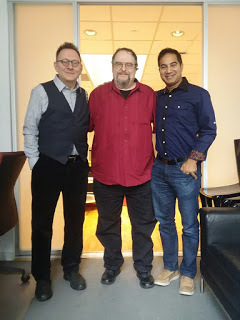 Messrs. Emerson, Grubb, and Khan.It was 2007 when I was last in New York (and that was for potentially turning Guild Wars into an animated TV series - nothing came of it). Back in the days of TSR, I was in town, regularly, in February, for Toy Fair. Toy Fair is still a thing, but I'm not there this time. This timeI was in town for a recording session for a game we're working on. I was recording lines with the brilliant Michael Emerson (of "Lost" and "Person of Interest") and the extremely talented Kamal Khan. I can't and won't give details, but both actors were fantastic.
Messrs. Emerson, Grubb, and Khan.It was 2007 when I was last in New York (and that was for potentially turning Guild Wars into an animated TV series - nothing came of it). Back in the days of TSR, I was in town, regularly, in February, for Toy Fair. Toy Fair is still a thing, but I'm not there this time. This timeI was in town for a recording session for a game we're working on. I was recording lines with the brilliant Michael Emerson (of "Lost" and "Person of Interest") and the extremely talented Kamal Khan. I can't and won't give details, but both actors were fantastic.
But I've noticed some differences of the town from almost ten years ago. There are more children and families in Manhattan than I noticed previously, and less sirens in the night. People honk less (I didn't say they stopped - I said they honked LESS). The lullaby of Broadway of continual gridlock is still there, but with less aggression.
One thing I had forgotten about was salad with breakfast. The complimentary breakfast provided from the hotel was completely insufficient (three muffins), so I ended up ordering an omelette each morning, and it came with a salad. That worked out well for me.
It snowed when I was out there. I mean, New York in February, so of course it snowed. A couple inches, enough to paralyze Seattle. Here it was a nice dusting. Families were sledding and building snowmen in Central Park.
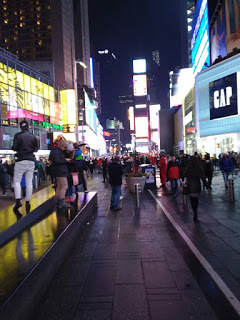 Bright Lights, Big CityWe were quartered right off of Times Square. New York hotel rooms are just as .... cozy ... as I remember. Times Square itself is America's Ginza district, and is amazing with its lights. In snow it is even brighter as each flake catches the light and reflects back. And yes, there were people everywhere, watching the snow.
Bright Lights, Big CityWe were quartered right off of Times Square. New York hotel rooms are just as .... cozy ... as I remember. Times Square itself is America's Ginza district, and is amazing with its lights. In snow it is even brighter as each flake catches the light and reflects back. And yes, there were people everywhere, watching the snow.
We had some down time, and took the opportunity to sight-see a little. Caught an exhibit on Stonewall at the New York Public Library by accident (we were checking out the architecture) on the way to the Tolkien exhibit at the Morgan Library. The latter was a beautiful small jewel box of an exhibit, crammed with all manner of Tolkien's artwork, both the famous (some of it graced various editions of the books) and the mundane (designs on crossword puzzles, creatures created for his children). Highly recommended.
I have a niece (who works for the NY Public Library System) who lives in Brooklyn with her husband (who is working with a startup), and so I journeyed one evening by subway down to her neck of the woods. The slotst hat used to take tokens are gone, now. Brooklyn was pretty nice, and reminded me of the North Halstead neighborhood of Chicago - lot of brick, neighborhood corner stores, quiet streets, a variety of apartments and homes. We went to a place that offered Thai Street Food, with dished like pad cha, weeping tiger, and something with five syllables that sounded vaguely Klingon. Excellent food.
My niece had warned me that the subways changed schedules on the weekends. Despite this, I and a companion got on a train heading for the American Museum of Natural History (about 81st street) but ended up under 125th street (walking distance to the Apollo in Harlem). A very helpful old man (from Brooklyn - he lived on the street that used as an establishing shot in "Welcome Back Kotter") told us what we did wrong and helpfully directed us to another platform, which didn't have ANY trains running on it (because, weekend). Finally found a transit authority figure in an orange vest who was helping out confused travelers.
Oh, yeah, did I mention that I have "talk to me" written on my forehead? Because that's what keeps happening. In New York City. On the subway. No, you don't need to talk to me! You have phones! Oh, all right, fine, tell me about your nephew in Queens.
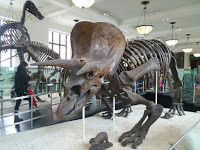 Serious skeletonageFirst time at the American Museum of Natural History. I grew up with the Carnegie Museum in Pittsburgh and loved the Field Museum in Chicago, and yet was very, very impressed. Their wildlife dioramas were amazing. The whale hanging over their Hall of Marine Life was great. I would give them the edge on the natural exhibits, but think the Field did better on exhibits on ethnography (other peoples). Parts were under renovation, it being February, including the Hall of the Pacific Northwest. Curious what they will do with it.
Serious skeletonageFirst time at the American Museum of Natural History. I grew up with the Carnegie Museum in Pittsburgh and loved the Field Museum in Chicago, and yet was very, very impressed. Their wildlife dioramas were amazing. The whale hanging over their Hall of Marine Life was great. I would give them the edge on the natural exhibits, but think the Field did better on exhibits on ethnography (other peoples). Parts were under renovation, it being February, including the Hall of the Pacific Northwest. Curious what they will do with it.
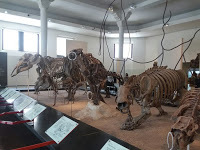 A necromancer's paradise.Their top floor - the Halls of Vertebrate Evolution - where they keep the dinosaurs, are just amazing. I don't think I have been in a museum with as much textural density in years. Their presentation take no prisoners - you have to keep up with the Latin names and clades and synaptic openings and maniraptors. I could have spent a full day on that floor alone. I officially feel behind the times when confronted with both the traditional presentation of equine evolution and how more recent fossils blow a hole in that traditional view of evolution.
A necromancer's paradise.Their top floor - the Halls of Vertebrate Evolution - where they keep the dinosaurs, are just amazing. I don't think I have been in a museum with as much textural density in years. Their presentation take no prisoners - you have to keep up with the Latin names and clades and synaptic openings and maniraptors. I could have spent a full day on that floor alone. I officially feel behind the times when confronted with both the traditional presentation of equine evolution and how more recent fossils blow a hole in that traditional view of evolution.
I went in search of a mural from my childhood, in some LIFE book on evolution. Could not find out, and now realize that it was in the Peabody Library at Yale. Ah. There were good murals of the mammals, though.
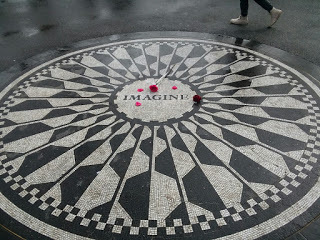 Strawberry FieldsDid not get to Ground Zero this time. It was hard enough to visit Strawberry Fields, which commemorates John Lennon. There was a young Asian woman playing Beatles tunes on a folk guitar and an artist selling "bad portraits" Yes, they were bad. Just being there was a bit of a hit to the stomach. I had to sit down on a snowy bench and pull myself together. Walking through Central Park was wonderful however, and I rewarded myself with a Nathan's Hotdog from a stand.
Strawberry FieldsDid not get to Ground Zero this time. It was hard enough to visit Strawberry Fields, which commemorates John Lennon. There was a young Asian woman playing Beatles tunes on a folk guitar and an artist selling "bad portraits" Yes, they were bad. Just being there was a bit of a hit to the stomach. I had to sit down on a snowy bench and pull myself together. Walking through Central Park was wonderful however, and I rewarded myself with a Nathan's Hotdog from a stand.
The New York food carts, by the way, have a lot more neon signs these days. And there are flatscreens on the subway. It is a very advanced world.
All that said, 432 Park Avenue, one of the tallest buildings in New York, is as ugly as sin. It is the box should hold a mammoth toothbrush. No picture, because it is so ugly.
I got down to the Strand Bookstore, which was heavenly. If you like Powell's City of Books in Portland, you'll be at home in the Strand. Lots of books, used and new, lots of people sprawled everywhere. Looked for some Nero Wolfe (I read Rex Stout's mysteries on the plane) but left with a volume of Johannes Cabal (The Fear Institute) by Johnathan L. Howards. Pro tip - there are cash registers elsewhere in the shop - you don't have to get in the big line by the entrance.
Failed to hunt down the neighborhood of Nero's Wolfe's brownstone either, though I understand that the block was completely rebuilt when the Lincoln Tunnel was pushed through. Still, there is a plaque somewhere for that.
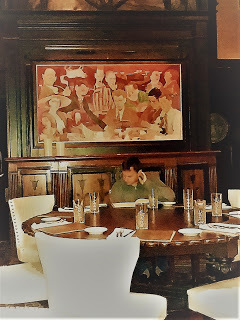 A round table, but not THE Round TableThe final evening I was on my own, and realized that my hotel was next door to the famous/infamous Algonquin Hotel, home of of the famous/infamous Algonquin Round Table. This was a daily lunch group of authors, editors, and other celebs that engaged in witty wordplay, logrolling, and mocking those who were not at the table. The restaurant has been renovated and the table itself is gone, but a portrait of the group does loom over a replacement table.
A round table, but not THE Round TableThe final evening I was on my own, and realized that my hotel was next door to the famous/infamous Algonquin Hotel, home of of the famous/infamous Algonquin Round Table. This was a daily lunch group of authors, editors, and other celebs that engaged in witty wordplay, logrolling, and mocking those who were not at the table. The restaurant has been renovated and the table itself is gone, but a portrait of the group does loom over a replacement table.
Took one of my producers out to New York Pizza. It is more than just a thin crust pizza - it is very good, and I am a fan of Chicago Pizza, so that's saying a lot.
I've said this before - New York City is a town that every American knows even if they have never been there. MAD Magazine, the New Yorker, Marvel comics, innumerable movies and TV shows. You know that location, and that building, and it all has a sense of familiarity about it. It is America's back-lot, and it is good to connect back to it again.
More later,
 Messrs. Emerson, Grubb, and Khan.It was 2007 when I was last in New York (and that was for potentially turning Guild Wars into an animated TV series - nothing came of it). Back in the days of TSR, I was in town, regularly, in February, for Toy Fair. Toy Fair is still a thing, but I'm not there this time. This timeI was in town for a recording session for a game we're working on. I was recording lines with the brilliant Michael Emerson (of "Lost" and "Person of Interest") and the extremely talented Kamal Khan. I can't and won't give details, but both actors were fantastic.
Messrs. Emerson, Grubb, and Khan.It was 2007 when I was last in New York (and that was for potentially turning Guild Wars into an animated TV series - nothing came of it). Back in the days of TSR, I was in town, regularly, in February, for Toy Fair. Toy Fair is still a thing, but I'm not there this time. This timeI was in town for a recording session for a game we're working on. I was recording lines with the brilliant Michael Emerson (of "Lost" and "Person of Interest") and the extremely talented Kamal Khan. I can't and won't give details, but both actors were fantastic.But I've noticed some differences of the town from almost ten years ago. There are more children and families in Manhattan than I noticed previously, and less sirens in the night. People honk less (I didn't say they stopped - I said they honked LESS). The lullaby of Broadway of continual gridlock is still there, but with less aggression.
One thing I had forgotten about was salad with breakfast. The complimentary breakfast provided from the hotel was completely insufficient (three muffins), so I ended up ordering an omelette each morning, and it came with a salad. That worked out well for me.
It snowed when I was out there. I mean, New York in February, so of course it snowed. A couple inches, enough to paralyze Seattle. Here it was a nice dusting. Families were sledding and building snowmen in Central Park.
 Bright Lights, Big CityWe were quartered right off of Times Square. New York hotel rooms are just as .... cozy ... as I remember. Times Square itself is America's Ginza district, and is amazing with its lights. In snow it is even brighter as each flake catches the light and reflects back. And yes, there were people everywhere, watching the snow.
Bright Lights, Big CityWe were quartered right off of Times Square. New York hotel rooms are just as .... cozy ... as I remember. Times Square itself is America's Ginza district, and is amazing with its lights. In snow it is even brighter as each flake catches the light and reflects back. And yes, there were people everywhere, watching the snow.We had some down time, and took the opportunity to sight-see a little. Caught an exhibit on Stonewall at the New York Public Library by accident (we were checking out the architecture) on the way to the Tolkien exhibit at the Morgan Library. The latter was a beautiful small jewel box of an exhibit, crammed with all manner of Tolkien's artwork, both the famous (some of it graced various editions of the books) and the mundane (designs on crossword puzzles, creatures created for his children). Highly recommended.
I have a niece (who works for the NY Public Library System) who lives in Brooklyn with her husband (who is working with a startup), and so I journeyed one evening by subway down to her neck of the woods. The slotst hat used to take tokens are gone, now. Brooklyn was pretty nice, and reminded me of the North Halstead neighborhood of Chicago - lot of brick, neighborhood corner stores, quiet streets, a variety of apartments and homes. We went to a place that offered Thai Street Food, with dished like pad cha, weeping tiger, and something with five syllables that sounded vaguely Klingon. Excellent food.
My niece had warned me that the subways changed schedules on the weekends. Despite this, I and a companion got on a train heading for the American Museum of Natural History (about 81st street) but ended up under 125th street (walking distance to the Apollo in Harlem). A very helpful old man (from Brooklyn - he lived on the street that used as an establishing shot in "Welcome Back Kotter") told us what we did wrong and helpfully directed us to another platform, which didn't have ANY trains running on it (because, weekend). Finally found a transit authority figure in an orange vest who was helping out confused travelers.
Oh, yeah, did I mention that I have "talk to me" written on my forehead? Because that's what keeps happening. In New York City. On the subway. No, you don't need to talk to me! You have phones! Oh, all right, fine, tell me about your nephew in Queens.
 Serious skeletonageFirst time at the American Museum of Natural History. I grew up with the Carnegie Museum in Pittsburgh and loved the Field Museum in Chicago, and yet was very, very impressed. Their wildlife dioramas were amazing. The whale hanging over their Hall of Marine Life was great. I would give them the edge on the natural exhibits, but think the Field did better on exhibits on ethnography (other peoples). Parts were under renovation, it being February, including the Hall of the Pacific Northwest. Curious what they will do with it.
Serious skeletonageFirst time at the American Museum of Natural History. I grew up with the Carnegie Museum in Pittsburgh and loved the Field Museum in Chicago, and yet was very, very impressed. Their wildlife dioramas were amazing. The whale hanging over their Hall of Marine Life was great. I would give them the edge on the natural exhibits, but think the Field did better on exhibits on ethnography (other peoples). Parts were under renovation, it being February, including the Hall of the Pacific Northwest. Curious what they will do with it. A necromancer's paradise.Their top floor - the Halls of Vertebrate Evolution - where they keep the dinosaurs, are just amazing. I don't think I have been in a museum with as much textural density in years. Their presentation take no prisoners - you have to keep up with the Latin names and clades and synaptic openings and maniraptors. I could have spent a full day on that floor alone. I officially feel behind the times when confronted with both the traditional presentation of equine evolution and how more recent fossils blow a hole in that traditional view of evolution.
A necromancer's paradise.Their top floor - the Halls of Vertebrate Evolution - where they keep the dinosaurs, are just amazing. I don't think I have been in a museum with as much textural density in years. Their presentation take no prisoners - you have to keep up with the Latin names and clades and synaptic openings and maniraptors. I could have spent a full day on that floor alone. I officially feel behind the times when confronted with both the traditional presentation of equine evolution and how more recent fossils blow a hole in that traditional view of evolution.I went in search of a mural from my childhood, in some LIFE book on evolution. Could not find out, and now realize that it was in the Peabody Library at Yale. Ah. There were good murals of the mammals, though.
 Strawberry FieldsDid not get to Ground Zero this time. It was hard enough to visit Strawberry Fields, which commemorates John Lennon. There was a young Asian woman playing Beatles tunes on a folk guitar and an artist selling "bad portraits" Yes, they were bad. Just being there was a bit of a hit to the stomach. I had to sit down on a snowy bench and pull myself together. Walking through Central Park was wonderful however, and I rewarded myself with a Nathan's Hotdog from a stand.
Strawberry FieldsDid not get to Ground Zero this time. It was hard enough to visit Strawberry Fields, which commemorates John Lennon. There was a young Asian woman playing Beatles tunes on a folk guitar and an artist selling "bad portraits" Yes, they were bad. Just being there was a bit of a hit to the stomach. I had to sit down on a snowy bench and pull myself together. Walking through Central Park was wonderful however, and I rewarded myself with a Nathan's Hotdog from a stand.The New York food carts, by the way, have a lot more neon signs these days. And there are flatscreens on the subway. It is a very advanced world.
All that said, 432 Park Avenue, one of the tallest buildings in New York, is as ugly as sin. It is the box should hold a mammoth toothbrush. No picture, because it is so ugly.
I got down to the Strand Bookstore, which was heavenly. If you like Powell's City of Books in Portland, you'll be at home in the Strand. Lots of books, used and new, lots of people sprawled everywhere. Looked for some Nero Wolfe (I read Rex Stout's mysteries on the plane) but left with a volume of Johannes Cabal (The Fear Institute) by Johnathan L. Howards. Pro tip - there are cash registers elsewhere in the shop - you don't have to get in the big line by the entrance.
Failed to hunt down the neighborhood of Nero's Wolfe's brownstone either, though I understand that the block was completely rebuilt when the Lincoln Tunnel was pushed through. Still, there is a plaque somewhere for that.
 A round table, but not THE Round TableThe final evening I was on my own, and realized that my hotel was next door to the famous/infamous Algonquin Hotel, home of of the famous/infamous Algonquin Round Table. This was a daily lunch group of authors, editors, and other celebs that engaged in witty wordplay, logrolling, and mocking those who were not at the table. The restaurant has been renovated and the table itself is gone, but a portrait of the group does loom over a replacement table.
A round table, but not THE Round TableThe final evening I was on my own, and realized that my hotel was next door to the famous/infamous Algonquin Hotel, home of of the famous/infamous Algonquin Round Table. This was a daily lunch group of authors, editors, and other celebs that engaged in witty wordplay, logrolling, and mocking those who were not at the table. The restaurant has been renovated and the table itself is gone, but a portrait of the group does loom over a replacement table.Took one of my producers out to New York Pizza. It is more than just a thin crust pizza - it is very good, and I am a fan of Chicago Pizza, so that's saying a lot.
I've said this before - New York City is a town that every American knows even if they have never been there. MAD Magazine, the New Yorker, Marvel comics, innumerable movies and TV shows. You know that location, and that building, and it all has a sense of familiarity about it. It is America's back-lot, and it is good to connect back to it again.
More later,
Published on March 20, 2019 21:00
March 17, 2019
Play:Theatrical Exorcism
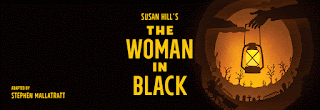 The Woman In Black, adapted by Stephen Mallatratt, from the novel by Susan Hill, Directed by Robin Herford, Seattle Rep through 24 March.
The Woman In Black, adapted by Stephen Mallatratt, from the novel by Susan Hill, Directed by Robin Herford, Seattle Rep through 24 March.Pity that I did not see this a few weeks back, when we were supposed to see it, but due to other obligations had to move the tickets to this past Sunday. And it is a pity because I would recommend it, but it has but a week to play out.
And the play worked for me in part because the Lovely Bride and I went into it stone cold. There were no ads on classical public radio that I caught, no reviews that may have occurred in the press, no summaries that I had a chance to read in advance. And we were caught in traffic on the way up to the theater, so breezed in at the very last moment before the curtain rose, so there was no chance to find out quite WHAT was going on. Indeed, once I tell you, even in the briefest form, your mind will immediately start to work on how it functions as a genre and as a theater piece, with the certainty of watching a movie's trailer and guessing spoilers.
You see, it is ghost story.
Ahah! I can see immediately that you know what I'm talking about. If there is a ghost story, there is a ghost, so we are already prepared for a haunting, and, armed with that familiarity. like seeing that trailer for a movie, you are already armed with assumptions and expectations. Armored against what is about to happen. Protected.
So, if you have any interest in the play (and you should - it has been running forever on London's East End), you should put aside this review until a later date - once you have seen it or let it pass beyond its current showings. Because it is a ghost story, and telling you that much changes how you see it. But I will tell you more.
The Woman In Black is adapted from a novel by Susan Hill, written in the 80s in the style of the "Female Gothic" novel - You know Jane Eyre, Frankenstein, that sort of thing. Moors and castles and secrets. Yes, now you have more armor, more than when I went in. It was a rather meaty novel, so turning its strengths on the printed page into results on the stage would be a challenge.
And they pull it off. Bradley Armacost is Arthur Kipps, who has hired an actor (known only as The Actor and played by Adam Wesley Brown). Kipps is a solicitor (ah, yes, it is a gothic, so England is its home) who seeks to exorcise a horrific experience in his life by sharing it with friends and family as a presentation. Kipps is a horrible neophyte to the theatre, to the point of reading the stage directions. The Actor sees the chance of making Kipps personal story something that could reach out and actually engage with others, and embraces him, challenges him, and takes over Kipp's part in his history. So we have The Actor playing the younger Kipps and Kipps playing all the other roles in the play within a play.
Both actors are marvelous. Brown moves between being the theatrical life-coach for Kipps to Kipps himself, neatly and enthusiastically, while Armacost sells us at the get-go as a plodding dullard of a solicitor, who over the course transforms himself into all the people he met on the dogs-end of Britain. Both men sell their selves and we are comfortable with them. And comfort is a part of horror.
I won't go into all the details of the plot - I've given you enough just telling you it is a ghost story. But I will say that stagecraft is wonderful as well. Starting with a bare stage and couple props, the story consumes and expands the world into the wilds of England, such that we are totally taken into the Actor's statement of the theatre selling reality, such that play-within-a-play may as well be the play and be reality. The walls break down, as it were.
But I am interested in how to do horror on the stage. Adapter Mallatratt's presentation adopts novelist Hill's concept of the slow boil of horror, which in theatre has the challenge that the audience may not tolerate anything slow on the stage. Yet the play works as it slowly, slowly turns up the existential unease of book-turned-play-turned-personal-testament, and does so neatly. It starts from a place of comfort and familiarity and ends up breaking the man so you understand in part why Kipps is like he is.
There are a lot of tools at work here. There are jump-scares. There is humor. There are characters and mysteries and things left unsaid and warnings and foreshadowing. There are remote locations and things that cannot be controlled. There are extremely clever things done with lights and sounds. There are sudden frights that leave the audience laughing, but they become uneasy laughs, such that the final revelations are sufficiently scary.
The initiating incident of the play is in people telling ghost stories at Christmas (a British thing), but even telling people "I'm telling a ghost story" gives the audience clues about what to expect - spoilers as it was. Yet that is the way of talking about horror - we get insulated from it - it was a story about someone else, not anyone you know. It is an old book found in the library or some uncle's keepsakes that reveal a Lovecraftian horror beneath the sea or just someone telling a story. Blankets against the cold.
But I have said too much. If you have the chance in the final week, go see it - indeed, one thing I noticed was that much of the crowd was younger, or at least less-grey, than my standard Sunday afternoon matinee. Ignore the posters in the lobby until the intermission (sorry, the interval) and the summary in the program book. So go see this play, but forget I said anything about ghosts. It's better that way.
More later,
Published on March 17, 2019 19:32
Jeff Grubb's Blog
- Jeff Grubb's profile
- 191 followers
Jeff Grubb isn't a Goodreads Author
(yet),
but they
do have a blog,
so here are some recent posts imported from
their feed.



